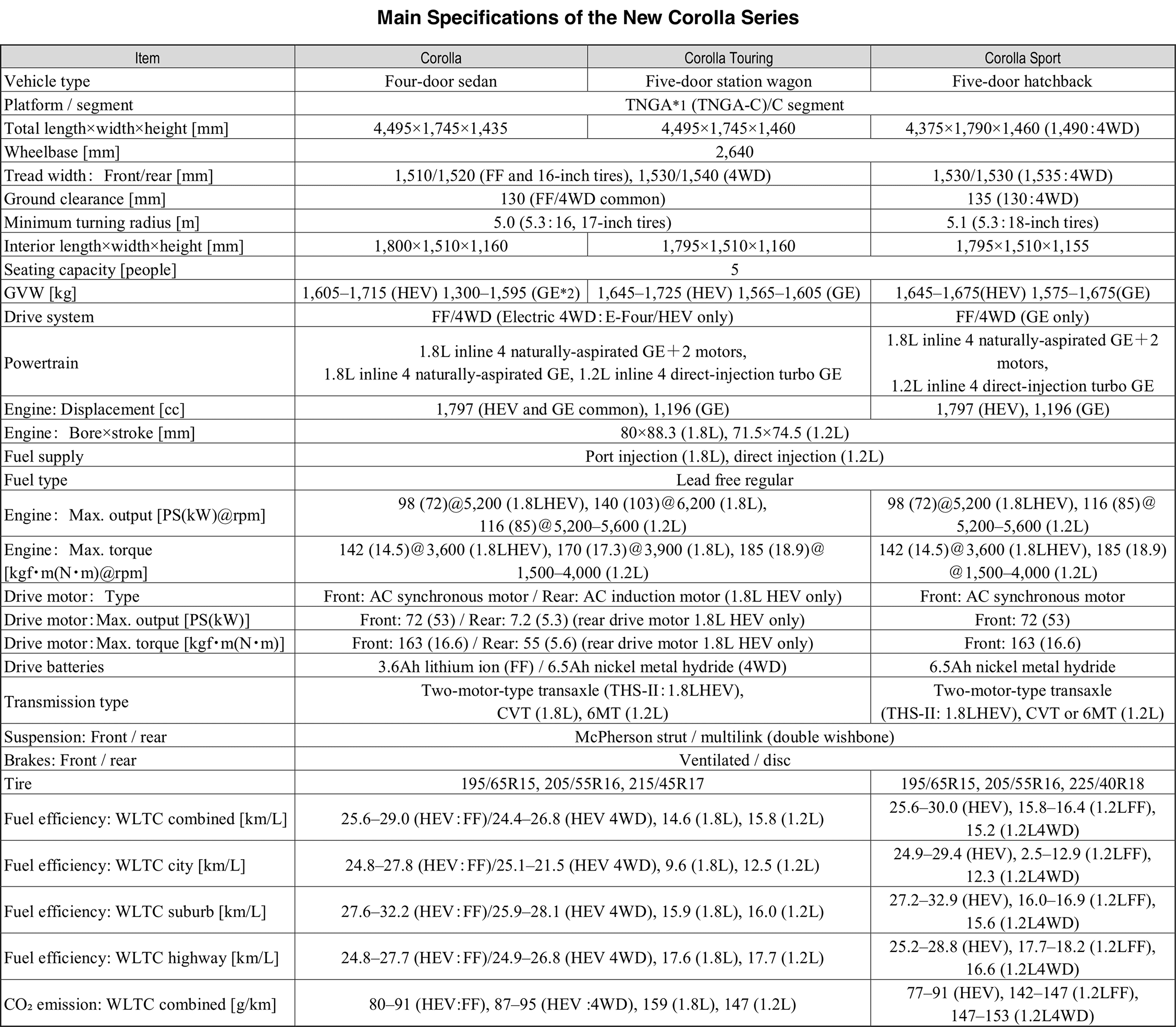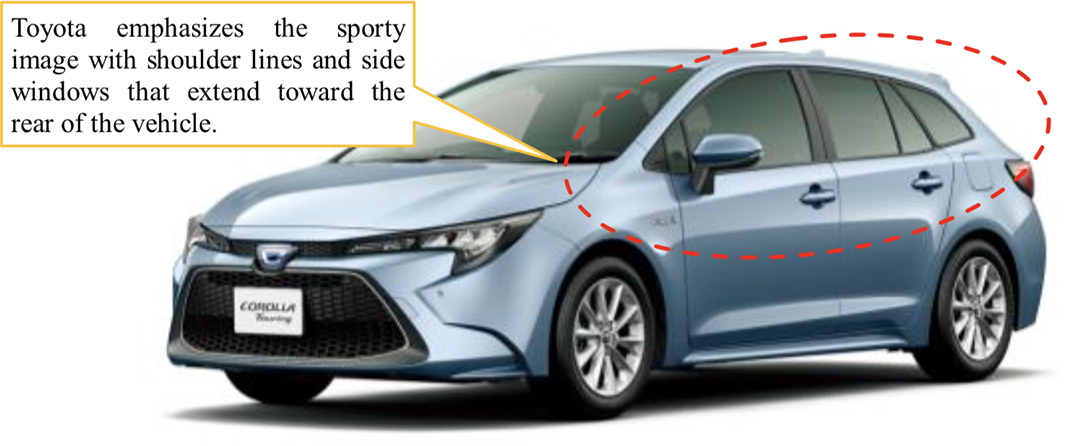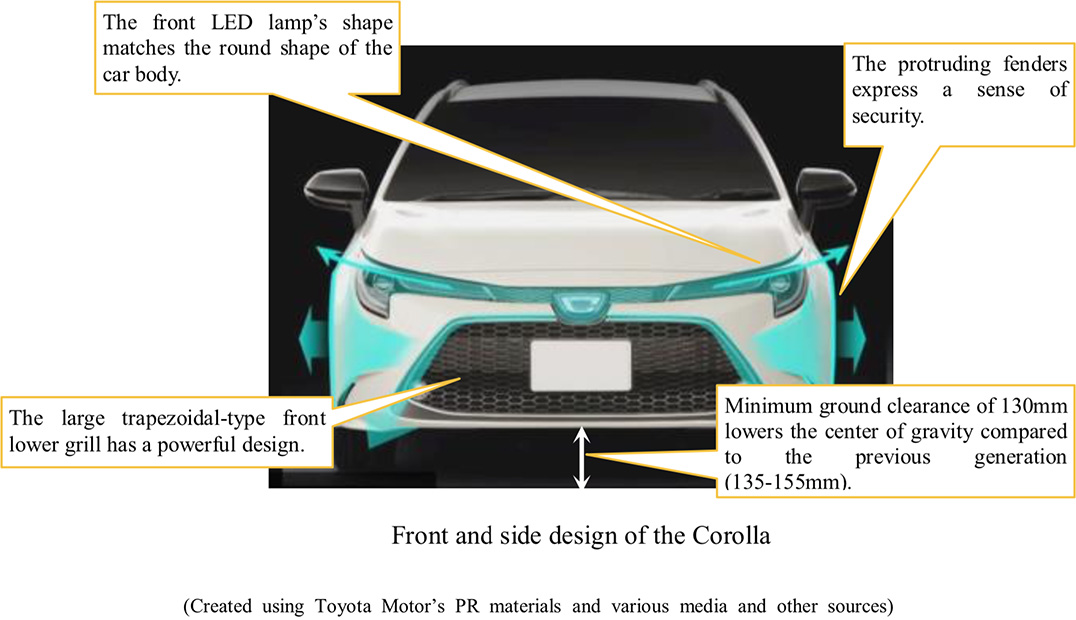AAA weekly
2019-11-11
Copyright FOURIN, Inc. 2025
Toyota Corolla: Adopting TNGA-C to Increase Size and Component Sharing Rate
Toyota Motor launched the Corolla Sport hatchback in June 2018. The Corolla sedan and Corolla Touring station wagon were added in September 2019.
Note: Section titles in this report match presentation titles listed in the event's pamphlet.
The Corolla, a representative model of Toyota, is a long-selling car which has been in production since 1966. The fully-redesigned new model is the 12th generation of the Corolla. The new Corolla is built on the TNGA platform. In addition to ensuring good styling and driving performance, Toyota promotes cost reduction through the sharing of component mounting layouts with other models and through the expansion of component sharing rate. In addition, the latest chassis control technology and connected services were added to increase product competitiveness.

Styling / Design
Toyota positions Corolla as a global strategic vehicle. It is developed by changing the body size and specifications in accordance with the local market needs around the world. The new Corolla released in Japan is built on the globally standardized TNGA platform (TNGA-C), but its design has been tailored specifically for the Japanese market. Although TNGA-C platform has increased the body, the increase was kept to a minimum to meet Japanese market needs. While the new Corolla is larger than the previous generation, it is still smaller than other Corolla models with overseas specifications. Furthermore, taking advantage of the wider tread, the steering angle of the tire was increased, setting minimum turning radius to 5.0 to 5.3 m which is about the same level as that of the predecessor model. As a result, despite increasing the body size, the model has excellent handling for urban driving.

Outline of the New Corolla Series
Vehicle type
・C segment: Sedan / station wagon / hatchback.
Release date (In Japan)
・The Corolla Sport hatchback was launched in June 2018. The Corolla sedan and Corolla Touring station wagon were added in September 2019.
Sales target (In Japan)
・Corolla: 1,700 units/month. Corolla Touring: 5,400 units/month. Corolla Sport: 2,300 units/month.
Base price (Including 10 percent consumption tax)
・Corolla: 1,936,000–2,948,000.
・Corolla Touring: 2,013,000–2,998,000.
・Corolla Sport: 2,169,000–2,825,000.
Rival models*
・Honda Civic, Mazda3, Subaru Impreza, etc.
Production plants (Models for the Japanese market)
・Toyota Takaoka Plant (Corolla/Corolla Touring), Toyota Tsutsumi Plant (Corolla Sport).
Model overview
・The Corolla, a representative model of Toyota, is a long-selling car which has been in production since 1966. Global sales until August 2019 reached 47.65 million units. The fully-redesigned new model is the 12th generation of the Corolla.
– In addition to the sedan model, the Corolla is also available in station wagon and hatchback versions. Along with the launch of the 12th generation, the model name of the sedan was changed from Corolla Axio to Corolla and the station wagon’s name was changed from Corolla Fielder to Corolla Touring. The Corolla Sport has been on the market under the name of Auris until its predecessor, but this time it has become one of the models of the Corolla series.
・Corolla tailors sizes and specifications in each market to local customer needs around the world. Japanese specifications are also designed exclusively for the Japanese market.
– In pursuit of high development efficiency in the areas of a sporty style, good driving performance and parts standardization, the platform of the new Corolla has been switched to the TNGA-C platform. However, the design has been altered in consideration of its use in Japan.
– The model series is equipped with the latest connected services and safety functions in an effort to differentiate it from competitive models to gain a larger market share in Japan.
– Toyota will continue to sell the predecessor models (Axio, Fielder) after the release of the new Corolla. Equipment will be changed to make these models more attractive to business users.
*Rival models are assumed by FOURIN based on body size, shape, price and other factors.
(Created using Toyota Motor’s PR materials and various media and other sources)
Styling and Design of the New Corolla Series
Styling

・Toyota introduced the TNGA platform, a vehicle design concept aimed at strengthening product competitiveness, to the 12th-generation Corolla.
– The model adopted the same TNGA-C platform as the 4th generation Prius. In pursuit of a low center of gravity and high rigidity, various parts and component mounting layouts were shared with other models which also reduced costs.
– The body size has been increased. However, in Japan, emphasis is placed on usability so size increase is minimized.
– Compared to the predecessor model, the overall length is increased by 95mm (Touring is 85mm), the overall width is increased by 50mm, and the overall height is reduced by 50mm. On the other hand, the overall length is reduced by 135mm (155mm for Touring) and the overall width is reduced by 35mm compared to overseas specifications.
– The minimum turning radius of the new standard grade Corolla is 5.0m, which is almost the same as that of the predecessor (4.9m) due to the expansion of the rudder angle of the tire. In the case of the upper grade (cars equipped with 17-inch tire), the minimum turning radius was shortened from 5.5m to 5.3m, ensuring good handling when traveling in urban areas.
Design
・The exterior design of the new Corolla series has a sporty and upscale styling.
– Based on the low center of gravity style, the side window design that extends from the front to the back of the car body and the shoulder line are combined to emphasize a stretchy and sporty image. In addition, its wide fenders and tires express a sense of security.


Please
register or subscribe to view this report for free.
If you’re already a subscriber, sign in.
Credit card information is not needed for free trial registration.
You are eligible to view one report for free.
Additional reports require subscription.


 ・Toyota introduced the TNGA platform, a vehicle design concept aimed at strengthening product competitiveness, to the 12th-generation Corolla.
– The model adopted the same TNGA-C platform as the 4th generation Prius. In pursuit of a low center of gravity and high rigidity, various parts and component mounting layouts were shared with other models which also reduced costs.
– The body size has been increased. However, in Japan, emphasis is placed on usability so size increase is minimized.
– Compared to the predecessor model, the overall length is increased by 95mm (Touring is 85mm), the overall width is increased by 50mm, and the overall height is reduced by 50mm. On the other hand, the overall length is reduced by 135mm (155mm for Touring) and the overall width is reduced by 35mm compared to overseas specifications.
– The minimum turning radius of the new standard grade Corolla is 5.0m, which is almost the same as that of the predecessor (4.9m) due to the expansion of the rudder angle of the tire. In the case of the upper grade (cars equipped with 17-inch tire), the minimum turning radius was shortened from 5.5m to 5.3m, ensuring good handling when traveling in urban areas.
・Toyota introduced the TNGA platform, a vehicle design concept aimed at strengthening product competitiveness, to the 12th-generation Corolla.
– The model adopted the same TNGA-C platform as the 4th generation Prius. In pursuit of a low center of gravity and high rigidity, various parts and component mounting layouts were shared with other models which also reduced costs.
– The body size has been increased. However, in Japan, emphasis is placed on usability so size increase is minimized.
– Compared to the predecessor model, the overall length is increased by 95mm (Touring is 85mm), the overall width is increased by 50mm, and the overall height is reduced by 50mm. On the other hand, the overall length is reduced by 135mm (155mm for Touring) and the overall width is reduced by 35mm compared to overseas specifications.
– The minimum turning radius of the new standard grade Corolla is 5.0m, which is almost the same as that of the predecessor (4.9m) due to the expansion of the rudder angle of the tire. In the case of the upper grade (cars equipped with 17-inch tire), the minimum turning radius was shortened from 5.5m to 5.3m, ensuring good handling when traveling in urban areas.



